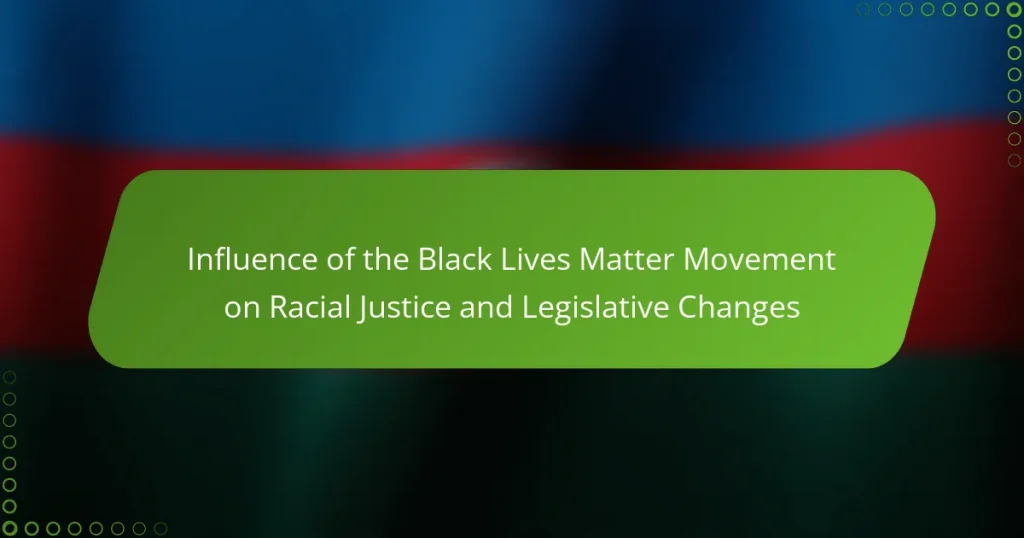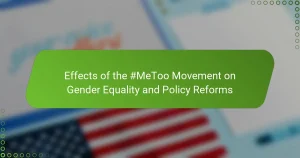The Black Lives Matter Movement is a significant activist campaign advocating for the rights and dignity of Black individuals, emerging in response to systemic racism and police violence. Founded in 2013, the movement gained prominence following the acquittal of George Zimmerman in the shooting death of Trayvon Martin and has since mobilized millions to address issues such as racial profiling, police brutality, and racial inequality. The movement’s influence is evident in the increased public discourse surrounding criminal justice reform and legislative changes, including notable bills like the California Act to Save Lives and the Eric Garner Anti-Chokehold Act. Through protests and solidarity actions, the Black Lives Matter Movement has fostered a more informed public and prompted corporations and institutions to reassess their policies on diversity and inclusion.
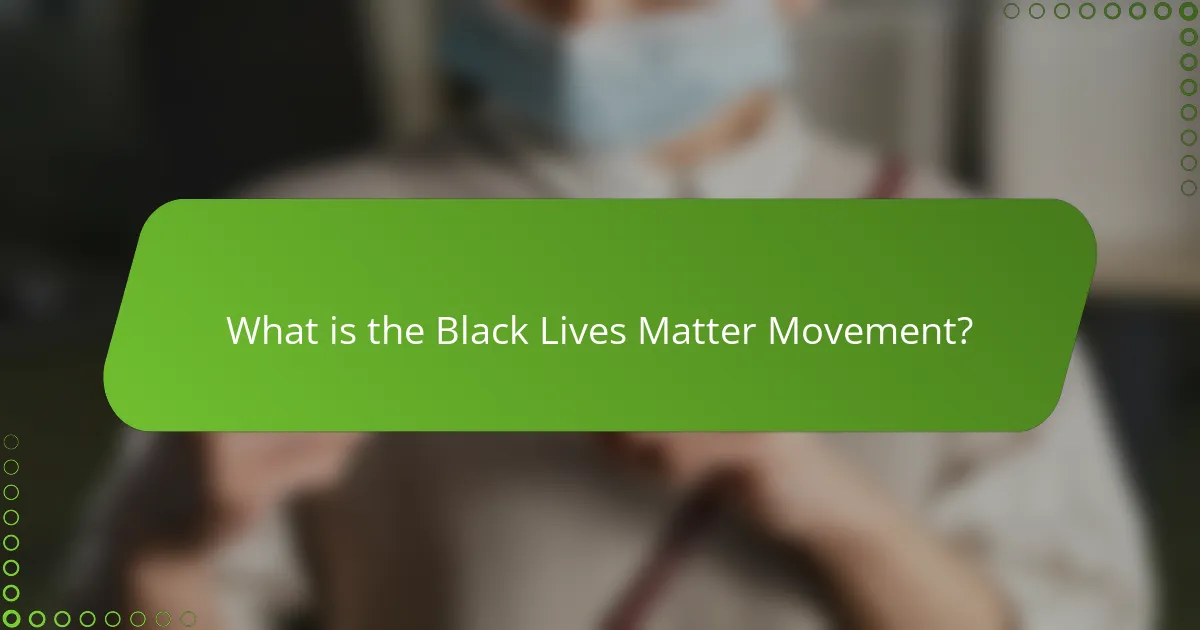
What is the Black Lives Matter Movement?
The Black Lives Matter Movement is an activist campaign advocating for the rights and dignity of Black individuals. It emerged in response to systemic racism and police violence against Black communities. Founded in 2013, the movement gained traction after the acquittal of George Zimmerman in the shooting death of Trayvon Martin. It seeks to address issues such as racial profiling, police brutality, and racial inequality. The movement has organized numerous protests and events to raise awareness and push for policy changes. Its influence is evident in discussions about criminal justice reform and racial equity. The movement has also inspired global solidarity actions and dialogues on race.
How did the Black Lives Matter Movement originate?
The Black Lives Matter Movement originated in 2013. It began as a response to the acquittal of George Zimmerman in the shooting death of Trayvon Martin. Activist Alicia Garza coined the phrase “Black Lives Matter” in a Facebook post. This post quickly gained traction and led to the hashtag #BlackLivesMatter. The movement was fueled by social media, allowing widespread dissemination of information. Protests erupted following incidents of police violence against Black individuals. The movement aims to address systemic racism and advocate for racial justice. It has since evolved into a global network advocating for policy changes.
What events sparked the formation of the Black Lives Matter Movement?
The Black Lives Matter Movement was sparked by the acquittal of George Zimmerman in the shooting death of Trayvon Martin in 2013. This event highlighted systemic racism and violence against Black individuals. The hashtag #BlackLivesMatter began circulating on social media following the verdict. Activists Alicia Garza, Patrisse Cullors, and Opal Tometi founded the movement in response. The movement gained momentum after the deaths of Michael Brown in Ferguson and Eric Garner in New York. These incidents further galvanized public outrage and protests against police brutality. The movement has since influenced discussions on racial justice and legislative reforms.
Who are the key figures involved in the Black Lives Matter Movement?
The key figures involved in the Black Lives Matter Movement include Alicia Garza, Patrisse Cullors, and Opal Tometi. They co-founded the movement in 2013 after the acquittal of George Zimmerman in the shooting death of Trayvon Martin. Alicia Garza is known for her activism and writing. Patrisse Cullors is recognized for her organizing skills and advocacy for racial justice. Opal Tometi has contributed significantly to the movement through her work in immigrant rights. These leaders have shaped the movement’s goals and strategies. Their collective efforts have raised awareness about systemic racism and police violence.
What are the core principles of the Black Lives Matter Movement?
The core principles of the Black Lives Matter Movement include the affirmation of Black humanity, dignity, and resilience. The movement emphasizes the importance of addressing systemic racism and police violence against Black individuals. It advocates for justice and accountability in cases of police brutality. The movement also seeks to uplift the voices of marginalized communities. Additionally, it promotes intersectionality, recognizing the interconnectedness of various social justice issues. The principles are rooted in the desire for societal change and equity. These principles guide the movement’s actions and campaigns. They aim to foster a more just and equitable society for all.
How does the movement address systemic racism?
The Black Lives Matter movement addresses systemic racism by advocating for policy reforms and raising awareness about racial injustices. It highlights issues such as police brutality, racial profiling, and economic inequality. The movement organizes protests and campaigns to demand accountability from law enforcement. It also seeks to influence legislation that promotes racial equity. For example, the movement has pushed for the abolition of discriminatory practices in the criminal justice system. Research indicates that BLM has successfully influenced public opinion regarding racial issues. According to a 2020 Pew Research Center study, 67% of Americans support the movement’s goals. This demonstrates the movement’s impact on societal attitudes toward systemic racism.
What role does intersectionality play in the Black Lives Matter Movement?
Intersectionality plays a crucial role in the Black Lives Matter Movement by addressing the interconnected nature of social categorizations. This concept highlights how race, gender, sexuality, and class intersect to create unique experiences of oppression. The movement recognizes that Black individuals face varied challenges based on these intersecting identities. For example, Black women experience both racism and sexism, leading to specific forms of discrimination. The movement’s founders, Alicia Garza, Patrisse Cullors, and Opal Tometi, emphasize inclusivity and the importance of diverse voices. This approach fosters solidarity among marginalized groups. Research shows that intersectionality enhances advocacy efforts and policy changes. By embracing intersectionality, the Black Lives Matter Movement aims for comprehensive racial justice that considers all facets of identity.
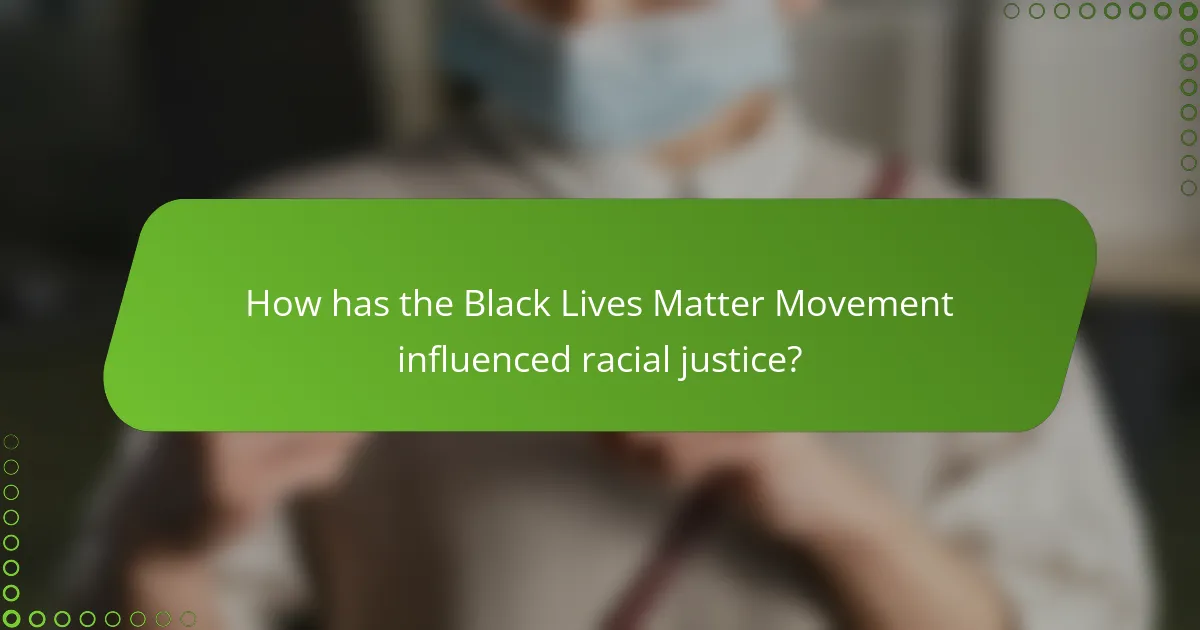
How has the Black Lives Matter Movement influenced racial justice?
The Black Lives Matter Movement has significantly influenced racial justice by raising awareness of systemic racism. It has mobilized millions to advocate for policy changes. The movement has led to increased public discourse about police brutality and racial inequality. High-profile incidents, such as the death of George Floyd, sparked widespread protests. These protests highlighted the urgent need for reform in law enforcement practices. Legislative changes, such as the George Floyd Justice in Policing Act, were introduced in response to the movement. Additionally, the movement has fostered solidarity among diverse communities advocating for justice. It has also prompted corporations and institutions to reassess their policies on diversity and inclusion. Overall, the movement has created a more informed and engaged public regarding racial justice issues.
What impact has the movement had on public awareness of racial issues?
The movement has significantly increased public awareness of racial issues. It has brought systemic racism and police brutality into mainstream conversation. High-profile incidents, such as the death of George Floyd, sparked widespread protests. These events amplified discussions on social media and traditional news outlets. Surveys indicate a rise in awareness among diverse demographics. For example, a Pew Research study shows that 67% of Americans believe racial inequality is a major issue. Additionally, the movement has influenced educational institutions to incorporate racial justice into their curricula. Overall, the movement has transformed public perception and understanding of racial issues in society.
How has the Black Lives Matter Movement changed perceptions of racism?
The Black Lives Matter Movement has significantly changed perceptions of racism by increasing awareness and prompting discussions about systemic inequality. It has highlighted the prevalence of racial discrimination in various sectors, including law enforcement and education. The movement’s visibility has led to a broader recognition of the Black experience in America. Public demonstrations have mobilized diverse groups to advocate for racial justice. Research indicates that social media campaigns have amplified these messages, reaching wider audiences. Surveys show a growing acknowledgment of racial bias among different demographics since the movement’s inception. The movement has influenced policy discussions, pushing for reforms in policing and criminal justice. Consequently, it has reshaped the national dialogue on race relations and accountability.
What role has social media played in the movement’s influence?
Social media has been crucial in amplifying the Black Lives Matter movement’s influence. It has facilitated real-time communication and mobilization among supporters. Platforms like Twitter and Instagram have allowed activists to share videos and images of incidents of racial injustice. This visual content has raised awareness and sparked global conversations. In 2020, the hashtag #BlackLivesMatter garnered over 8 million tweets within a few weeks. Social media has also enabled grassroots organizing and fundraising efforts. Campaigns can quickly reach a wide audience, leading to increased participation in protests. Overall, social media has transformed how movements gain traction and influence public discourse.
In what ways has the movement prompted community engagement?
The Black Lives Matter movement has prompted community engagement through organized protests, educational initiatives, and local activism. These protests have mobilized thousands of participants, raising awareness about racial injustice. Educational initiatives have included workshops and discussions that inform communities about systemic racism. Local activism has led to grassroots campaigns focused on policy changes. For example, many local groups have advocated for police reform and accountability measures. The movement has also fostered collaborations among diverse community organizations. Additionally, social media has played a crucial role in spreading information and rallying support. According to a 2020 Pew Research Center survey, 15% of Americans reported participating in a Black Lives Matter protest. This indicates a significant increase in community involvement in racial justice issues.
How have grassroots organizations been affected by the movement?
Grassroots organizations have gained increased visibility and support due to the movement. The Black Lives Matter movement has mobilized communities and inspired collective action. This surge in activism has led to a rise in funding and resources for these organizations. Many grassroots groups have expanded their outreach and initiatives in response to heightened awareness of racial injustice. For instance, donations to organizations like the NAACP and Movement for Black Lives increased significantly during peak protest periods. Additionally, grassroots organizations have formed coalitions to amplify their voices and impact. The movement has also encouraged more individuals to engage in local activism. Overall, grassroots organizations have experienced both growth and a strengthened network as a direct result of the movement.
What initiatives have emerged as a result of the movement’s influence?
The Black Lives Matter movement has led to several significant initiatives. One major initiative is the establishment of community-led policing reforms. These reforms aim to increase accountability and transparency within law enforcement agencies. Another initiative is the push for legislative changes regarding police practices, such as banning chokeholds and implementing body cameras.
Additionally, the movement has inspired educational programs focused on racial equity and justice. These programs aim to raise awareness and foster discussions around systemic racism. The movement has also influenced the creation of funding initiatives for community services rather than police funding.
These initiatives reflect the broader impact of the Black Lives Matter movement on societal attitudes and policy reforms regarding racial justice.
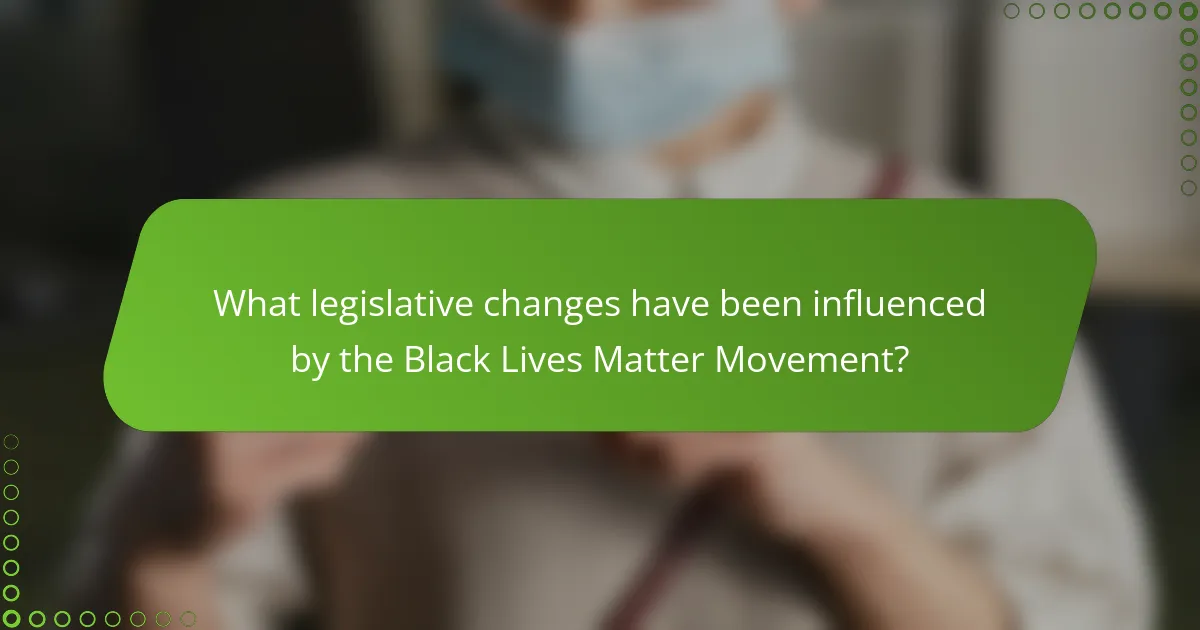
What legislative changes have been influenced by the Black Lives Matter Movement?
The Black Lives Matter Movement has influenced several legislative changes aimed at addressing racial injustice. Notable changes include police reform bills in various states. For instance, California passed the California Act to Save Lives in 2020. This legislation aims to reduce police use of force and increase accountability. Similarly, New York enacted the Eric Garner Anti-Chokehold Act in 2020. This law makes the use of chokeholds by police officers a felony. Additionally, several cities have implemented bans on no-knock warrants. These changes reflect a broader push towards criminal justice reform inspired by the movement.
What specific laws have been enacted in response to the movement?
Several specific laws have been enacted in response to the Black Lives Matter movement. One significant law is the George Floyd Justice in Policing Act of 2021. This act aims to address police misconduct and increase accountability. It includes provisions to prohibit chokeholds and no-knock warrants at the federal level.
Another important legislation is the John Lewis Voting Rights Advancement Act. This law seeks to restore and strengthen voting rights protections. It was introduced to counteract voter suppression tactics that disproportionately affect communities of color.
Additionally, various states have enacted their own reforms. For example, California passed the California Act to Save Lives. This law mandates the use of de-escalation tactics by law enforcement.
These laws reflect a broader movement towards racial justice and accountability in policing. They are direct responses to demands for systemic change highlighted by the Black Lives Matter movement.
How have local governments responded to the calls for police reform?
Local governments have responded to calls for police reform by implementing various policy changes. Many cities have adopted measures to increase police accountability. For example, some jurisdictions have mandated body cameras for officers. Others have introduced new training programs focused on de-escalation techniques. Additionally, local governments have established civilian oversight boards to review police conduct. In 2020, over 20 cities enacted bans on chokeholds and other restrictive practices. These actions reflect a broader movement towards reform in response to public outcry.
What national legislation has been proposed or passed due to the movement?
The George Floyd Justice in Policing Act is national legislation proposed due to the Black Lives Matter movement. This act aims to address police misconduct and enhance accountability. It includes provisions for banning chokeholds and no-knock warrants at the federal level. The legislation also seeks to establish a national database to track police misconduct. Additionally, it promotes training for law enforcement on racial bias and de-escalation techniques. The act was introduced in 2020 following widespread protests against racial injustice. Although it passed in the House, it faced challenges in the Senate. The movement has significantly influenced discussions around police reform and racial justice legislation.
How has the movement influenced policy discussions at various levels of government?
The Black Lives Matter movement has significantly influenced policy discussions at various levels of government. Local governments have adopted reforms in policing practices, such as banning chokeholds and implementing body cameras. State legislatures have considered bills aimed at police accountability and racial justice. For instance, California passed the California Act to Save Lives, which requires de-escalation training for law enforcement. Nationally, the movement has prompted discussions about systemic racism and police funding, leading to proposals for reallocating resources. The George Floyd Justice in Policing Act was introduced in Congress as a direct response to the movement’s advocacy. These discussions reflect a growing recognition of racial disparities in the justice system.
What role have protests played in shaping legislative priorities?
Protests have significantly influenced legislative priorities by raising public awareness and urgency around social issues. The Black Lives Matter movement, for example, has spotlighted systemic racism and police violence. This increased visibility has prompted lawmakers to reconsider existing policies. In 2020, following widespread protests, several states introduced police reform bills. These bills aimed to address issues such as excessive force and accountability. Research shows that public protests can lead to legislative action, as seen in the aftermath of the George Floyd protests. According to a study by the National Bureau of Economic Research, protests can shift public opinion and pressure legislators to act. Thus, protests serve as a catalyst for change in legislative priorities.
How have lawmakers responded to the demands of the Black Lives Matter Movement?
Lawmakers have responded to the demands of the Black Lives Matter Movement by introducing and passing various legislative measures aimed at police reform and racial justice. For instance, the George Floyd Justice in Policing Act was introduced in 2020 to address systemic racism in law enforcement. This act includes provisions for banning chokeholds, establishing a national database for police misconduct, and limiting the transfer of military equipment to police departments. Additionally, several states have enacted laws to mandate body cameras for police officers and improve transparency in police practices. These legislative efforts reflect the influence of the movement on public policy and highlight a growing recognition of the need for reform in policing.
What are the future implications of the Black Lives Matter Movement on racial justice and legislation?
The Black Lives Matter Movement will likely lead to significant changes in racial justice and legislation. It has already influenced public discourse on systemic racism. Policymakers are increasingly pressured to address racial disparities. Legislative reforms could include police accountability measures and criminal justice reform. The movement has mobilized grassroots activism, creating a sustained demand for change. Studies show that movements like BLM can lead to legislative action when they maintain momentum. Future implications may also involve broader coalitions advocating for equity. Overall, the movement’s impact on racial justice and legislation is poised to grow.
How can communities continue to advocate for change beyond the movement?
Communities can continue to advocate for change beyond the movement by establishing ongoing dialogues and partnerships. Engaging local leaders and organizations fosters collaborative efforts. Regular community meetings can help maintain momentum and address emerging issues. Utilizing social media platforms allows for widespread awareness and mobilization. Educational programs can empower individuals with knowledge about racial justice. Grassroots campaigns can sustain advocacy efforts at local levels. Research shows that sustained advocacy leads to long-term policy changes. For example, the NAACP’s continuous efforts have influenced legislation over decades.
What lessons can be learned from the Black Lives Matter Movement for future activism?
The Black Lives Matter Movement teaches several key lessons for future activism. First, grassroots organizing is essential for mobilizing communities. The movement effectively utilized social media to raise awareness and engage supporters. Second, intersectionality is crucial; addressing various social issues strengthens the movement. The BLM movement highlighted the connections between race, gender, and class in activism. Third, sustained pressure on institutions can lead to change. Protests and advocacy have prompted legislative discussions on police reform. Fourth, building coalitions with other movements enhances impact. Collaborations with groups focused on issues like climate change and labor rights have expanded the movement’s reach. Lastly, the importance of storytelling in advocacy cannot be overstated. Personal narratives have humanized the issues and fostered empathy among diverse audiences. These lessons can guide future activism towards more effective and inclusive strategies.
The Black Lives Matter Movement is a significant activist campaign advocating for the rights and dignity of Black individuals, emerging in response to systemic racism and police violence. Founded in 2013, it has mobilized protests and discussions around racial profiling, police brutality, and legislative reforms. Key figures like Alicia Garza, Patrisse Cullors, and Opal Tometi have shaped its principles, emphasizing intersectionality and community engagement. The movement has influenced public awareness and legislative changes, including police reform bills and initiatives aimed at addressing racial injustice, demonstrating its impact on societal attitudes and policy discussions regarding racial equity.
